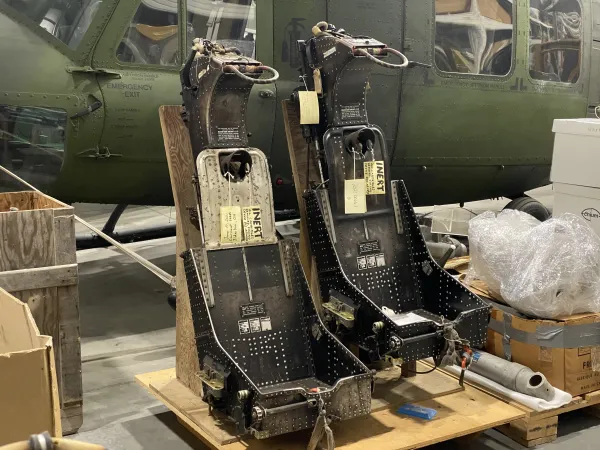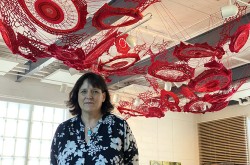How a pair of ejection seats from the Avro CF-105 Arrow survived
When the Avro Arrow project was cancelled by the federal government in 1959, the six planes already constructed were to be completely destroyed. Fortunately, a pair of ejection seats survived. This is their story.
Three seconds. That’s how long it takes for an aircraft ejector seat to do its job. Once the lever is pulled, the canopy is blown off. The seat harness tightens, cinching the pilot in place as a controlled explosive is discharged at the rear of the seat, accelerating it vertically at more than 24 metres per second (80 feet per second), violently ejecting the seat into the air and out of the doomed aircraft. The drogue chute deploys to stabilize the freefall, followed by the main chute that transports the pilot safely to the ground. And all it took was three seconds.
Prior to the invention of ejection seats, when an aircraft suffered catastrophic failure while airborne, the chances of making it out safely were bleak. The primary means of escape was for the pilot to invert the aircraft, open the canopy, unbuckle themselves, fall out and manually deploy a parachute – no mean feat considering the confined space, the g-forces, the airflow past the aircraft, and other factors. Fortunately, it was a problem that was being worked on from the early days of flying.
In 1916, Everard Calthrop, an early inventor of parachutes, patented an ejector seat using compressed air and, by the late 1920s, Romanian inventor Anastase Dragomir patented the modern layout of an ejector seat, with the design being perfected during World War II. The British firm Martin-Baker – the present world leading designer and manufacturer of ejection seats – started working on ejection seats in 1934. By 1946, they began live-testing the Mk 1, a revolutionary new seat that blew off the aircraft canopy, restrained the pilot in the seat, and automatically deployed a parachute. Since then, Martin-Baker ejection seats alone have saved more than 7,500 aircrew lives.
Origin stories like these tend to pique the interest of aviation enthusiasts like Ray Corsaut, who had been watching the yellow Harvards aircraft fly during World War II since he was four years old. Back in 1977, he found himself at a government surplus auction on the hunt for unique memorabilia when he came across a pair of ejection seats, which he promptly purchased and stored in his barn in Ilderton, Ont. At the time, he didn’t know much about this particular pair, he assumed they were ejection seats from the Arrow’s predecessor, the CF-100. One night, as he pored over a book about the Avro CF-105 Arrow – Canada’s first and only Canadian-designed supersonic aircraft – he came across a section that made him pause and stare long and hard. The description of the ejection seats looked familiar. It was late at night, but he picked up his flashlight and headed to the barn unable to contain his excitement and to confirm what he suspected. He may have a pair of seats from the famed aircraft.
Not being an expert in seats, Corsaut needed to confirm that his seats were indeed from the Avro CF-105 Arrow., he met Wilf (Wilfred) Farrance, who had been responsible for cockpit implementation for the Arrow project, who kindly visited his barn to look at the seats and told Corsaut what he wanted to hear. He was indeed in possession of seats 5 (Pilot) and 6 (Observer) from aircraft RL-203, the third Arrow to be built!
The Avro CF-105 Arrow, developed during the Cold War in the 1950s, was cutting edge technology for its time. It was thus equipped with the latest generation of Martin-Baker ejection seats, the Mk-C5, the ‘C’ denoting a Canada specific model.
There is a bit of mystique surrounding how these seats came to be at a government surplus auction in 1977. When the Avro Arrow project was cancelled in 1959, the company was supposed to destroy all six completed aircraft and others under construction. Of the 20 Mk-C5 seats produced, only 12 were installed in aircrafts. The seats were to be removed and returned to Martin-Baker in England. Surprisingly, they were still here in Canada.
Better yet, right now they are part of the Ingenium collection.

Ray Corsaut at the now defunct Toronto Aerospace Museum in Downsview, Toronto
In June 2008, Ray Corsaut and his wife Margaret visited the Canada Aviation and Space Museum. They met Marc Ducharme, Director of Visitor Experiences at the time and conversed about the seats. Ducharme took them on a tour of the museum hangar and showed them the wingtips from the Avro CF-105 Arrow in the collection. That day, Ray indicated he would like to bequeath his pair of ejection seats to the museum on his death. Staying true to that promise, when Ray passed away in December 2019, Margaret contacted the museum with details and pictures of the seats. It’s not often that the museum has such priceless artifacts find them – it’s usually the other way around. At the same time, Erin Gregory, Curator of the Canada Aviation and Space Museum, was preparing proposals to acquire two more Avro Arrow-related artifacts, a drafting table and a Delta test vehicle. She felt this would be the perfect addition to illustrate the history of the Avro CF-105 Arrow from design, with the drafting table, to testing, with the Delta test vehicle, and to the final product, with the ejection seats. Coincidentally, the seats came from the same aircraft – the RL-203 – of which the museum already possessed a pair of wingtips. And while individual Avro CF-105 Arrow seats exist in collections elsewhere, no one possessed two from the same aircraft, making this set extremely rare. Gregory went to work putting a proposal together, since every acquisition needs a formal assessment explaining how it fits into or enhances the overall collection at the museum. And while Ingenium was under an acquisition moratorium at the time, they were still accepting proposals that met Outstanding Significance and National Importance (OSNI) criteria, which these seats fulfilled. The Acquisition Committee, chaired by the vice-president of the Collection and Research Branch and comprised of voting members from the Curatorial Division, Collection and Conservation Services, and a Director General, approved the proposal. And a team was sent out to acquire the seats.
The team arrived at Margaret Corsaut’s home in Ilderton, Ont., and headed to the barn. Conservator Réjean Demers’ primary concern was safety. The Martin-Baker Mk-C5 seats in normal operation would be equipped with multiple explosives, all actuated through mechanical percussion of the cartridge detonation charge. These could still be present and pose a risk to anyone handling the seats. According to the data plates on the seats, they were manufactured June 1958, and with no further information, they would need to be carefully inspected before being transported.
In preparation for this, Demers spent a lot of time researching the Martin-Baker Mk-C5. He came across manuals online and detailed descriptions and diagrams. While not a lot of information was available for the Mk-5 and even less about the Canada-specific Mk-C5, he learned it was very similar to the Mk-4. Armed with this knowledge and his experience as an Aircraft Maintenance Engineer, Demers got to work methodically inspecting the pilot and observer seats for explosives. The Main Ejector Gun has a primary charge and two secondary charges that propel the seat along the guide rails and out of the aircraft. Another explosive cartridge is present in the Drogue Gun. After painstakingly and carefully confirming all explosive cartridges were absent, Demers breathed a huge sigh of relief. The only part of the seat he wasn’t able to render inert on site was the Timing Unit. It is the device that sets off the charges in a fixed sequence, and it is all held together by mechanical tension. The solution was to detach it from the seat and place it in a specialized box with a steel detonation chamber, which would allow it to release its energy in a safe manner, if needed.
Now that they were deemed safe to be moved, the team secured the seats in a vehicle and transported them to the Canada Aviation and Space Museum, where they are being prepared for display for an upcoming Cold War exhibition that will feature more parts from the Avro CF-105 Arrow.
We owe a debt to enthusiasts like Ray Corsaut who collect, preserve, and donate artifacts like these. With very little to support them other than passion and sheer dedication, they are the unsung patrons of history that afford us glimpses into the past and how we got to where we are.
Enjoying the Ingenium Channel? Help us improve your experience with a short survey!














![A block of photographs showing some of the people involved in the bombing of beluga whales in the estuary and gulf of the St. Lawrence River. Anon., “La chasse aux marsouins [sic]. » Le Devoir, 15 August 1929, 6.](/sites/default/files/styles/thumbnail_7/public/2024-09/Le%20Devoir%2015%20aout%201929%20page%206.jpg?h=584f1d27&itok=TppdLItg)


